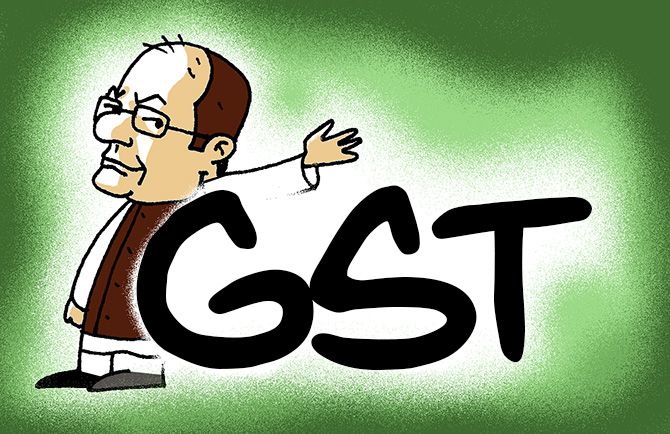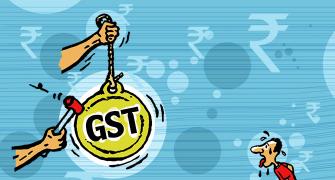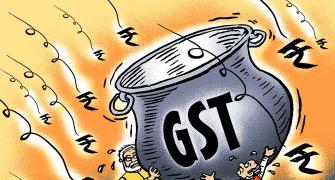It is possible that the Centre has now become wiser and has decided to follow an allocation system which gives it more from Integrated GST and helps boost its revenues, says A K Bhattacharya.
Illustration: Dominic Xavier/Rediff.com

Collections under the Goods and Services Tax (GST) in April 2019 have inspired many commentators to believe that the revenue shortfalls, seen under this head in all the past months since its inception in July 2017, will soon be a thing of the past.
Even some government officials have expressed the hope that Rs 1.14 trillion of GST collected in the first month of the current financial year would help them meet the target set in the interim Budget for 2019-20.
How realistic are these beliefs and assumptions?
The government’s expectations of meeting the target are primarily based on the way it has allocated the revenues collected under the Integrated GST or IGST to the Centre under the Central GST (CGST) and to the states under the State GST (SGST).
Remember that the IGST is a tax levied on all inter-state supplies of goods and services, and on imports.
Now, in April 2019 as much as Rs 54,733 crore came from the IGST, while Rs 21,163 crore were collected from the CGST, Rs 28,801 crore from the SGST and Rs 9,168 crore from the GST Compensation Cess.
That made it a total GST collection of Rs 1.14 trillion.
Out of the Rs 54,733 crore collected under the IGST, the government allocated Rs 20,370 crore, or about 37 per cent, to the CGST and Rs 15,975 crore (29 per cent) to the SGST.
Another Rs 12,000 crore collected under the IGST was shared equally between the Centre and the states.
After this settlement, the IGST was left with Rs 6,388 crore, which too should remain with the Centre.
This raised the total IGST allocations at Rs 32,758 crore for the CGST and Rs 21,975 crore for the SGST.
In other words, the Centre apportioned for itself about 60 per cent of the IGST collected in April, and the states got about 40 per cent.
This appears to indicate a significant change in the sharing formula followed in the first few months after the launch of the GST in July 2017.
States got higher allocations from the IGST for all the eight months of 2017-18 (from August 2017 to March 2018) and for April 2018.
The allocations for the CGST began to be higher than those for the SGST from May 2018, but the difference used to be very small.
For instance, the CGST’s share in the IGST was just 52 per cent even in October 2018, compared to the SGST’s share of 48 per cent.
It is of course logical that the CGST’s share in the IGST should be a little higher than that of the SGST.
This is because most taxpayers adjust their IGST credit first against the CGST and then against the SGST.
Thus the unallocated IGST should naturally belong more to the CGST and less to the SGST.
But what has happened in April 2019 is a sharp swing in the IGST allocations in favour of the CGST.
It is possible that the Centre has now become wiser and has decided to follow an allocation system which gives it more from the IGST and helps boost its revenues.
But the states will obviously be unhappy and they are likely to complain about this once the elections are over.
With a 60 per cent share in IGST, the Centre’s collections under GST in April 2019 were estimated at Rs 53,921 crore.
If the target of Rs 6.6 trillion of CGST and IGST revenues in 2019-20 is to be met, the average monthly collections should be about Rs 55,000 crore.
Thus, the shortfall in April 2019 is only about Rs 1,079 crore, much lower than what it used to be in all the months of 2018-19.
But once you change the formula for sharing the IGST with the states, the GST collections in April do not look that impressive.
The assessment of whether the tax collections are enough to meet the annual target is also dependent on the way the GST system works.
A portion of the revenues collected in any month under the GST system pertains to some transactions conducted in the previous month and some transactions in the month of the collections.
But the portion of revenues from transactions conducted in the previous month is always much larger when the collections are for the first month of a financial year.
This is because transactions usually see a huge bump in the last few weeks of the last month of a financial year.
Thus the April collections in the GST system see a more than normal increase.
In April 2018, the GST revenues touched Rs 1.03 trillion, the first time it crossed the Rs 1-trillion mark.
It also jumped by 12 per cent over Rs 92,167 crore collected in March 2018.
But in May 2018, GST collections were only Rs 94,016 crore, a decline of over nine per cent.
So, don’t be surprised if the GST collections, after recording a month-on-month rise of 7.5 per cent in April 2019, also record a similar decline in May 2019.
The April 2019 collections, however, should give the government comfort for a different reason.
The GST revenues have gradually stabilised at a slightly higher rate of monthly collections.
Between August 2017 and March 2018, the monthly collections hovered at around Rs 84,000 crore to Rs 96,500 crore.
During 2018-19, the monthly collections crossed the Rs 1-trillion mark on four occasions.
In this period, the GST Council cut rates on a large number of items twice - once in November 2017 and again in December 2018.
In spite of that, monthly collections under the SGST have risen from around Rs 22,000 crore in December 2018 to Rs 28,800 crore in April 2019.
For the CGST as well, the growth has been significant - from about Rs 16,400 crore in December 2018 to Rs 21,100 crore in April 2019.
These are positive signs for a new taxation system.
But it is the 60:40 formula for sharing the IGST collections in favour of the CGST that has given the Centre an added advantage in meeting its annual GST target.
States are likely to view this as an unfair formula.
Once that formula changes, the prospects for the Centre’s own GST collections may not remain as bright as they appear now.










